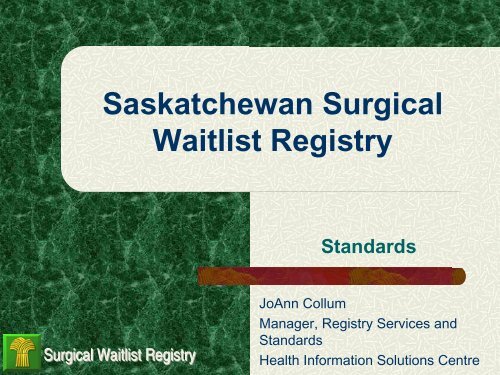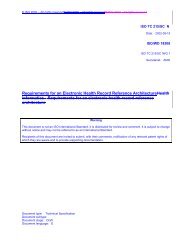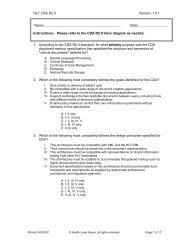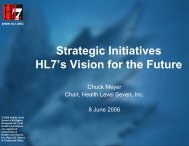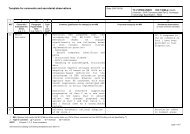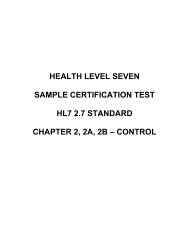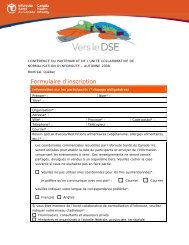Standards Saskatchewan Surgical Waitlist Registry
Standards Saskatchewan Surgical Waitlist Registry
Standards Saskatchewan Surgical Waitlist Registry
- No tags were found...
Create successful ePaper yourself
Turn your PDF publications into a flip-book with our unique Google optimized e-Paper software.
<strong>Saskatchewan</strong> <strong>Surgical</strong><strong>Waitlist</strong> <strong>Registry</strong><strong>Standards</strong><strong>Surgical</strong> <strong>Waitlist</strong> <strong>Registry</strong>JoAnn CollumManager, <strong>Registry</strong> Services and<strong>Standards</strong>Health Information Solutions Centre
<strong>Surgical</strong> <strong>Waitlist</strong> <strong>Registry</strong>SSCN Initiative – Access to Care• Provinces and territories have all faced theissue of waiting times and we have allincreased funding in this area.• We have also recognized that funding alone isnot the solution.
<strong>Surgical</strong> <strong>Waitlist</strong> <strong>Registry</strong>Wait List Management Initiative• <strong>Saskatchewan</strong> outlined its surgical care strategy withinthe Action Plan for <strong>Saskatchewan</strong> Health Care (2002).It lists several priority initiatives, including theestablishment of:‣ The <strong>Saskatchewan</strong> <strong>Surgical</strong> Care Network (SSCN);‣ A <strong>Surgical</strong> Patient <strong>Registry</strong>;‣ A Clinical Prioritization Process & Target Time Frames forSurgery;‣ A Waiting List Web Site; and‣ <strong>Surgical</strong> Care Coordinators and Regional Contacts
<strong>Surgical</strong> <strong>Waitlist</strong> <strong>Registry</strong>Pulling the Strategy Together• To oversee development and implementation of the initiatives, the<strong>Saskatchewan</strong> <strong>Surgical</strong> Care Network (SSCN) was establishedas an advisory body to <strong>Saskatchewan</strong> Health in March 2002.• Peter Glynn, was appointed as Chair of the Network, along with15 members representing surgeons, Health Regions, regulatorybodies and <strong>Saskatchewan</strong> Health.• SSCN’s vision is:“Timely and appropriate surgical care for all <strong>Saskatchewan</strong>residents”.
<strong>Surgical</strong> <strong>Waitlist</strong> <strong>Registry</strong>SSCN MembershipCo-Chairs: Peter Glynn, Ph.D. &Dr. Rob Weiler (Anesthetist, Saskatoon)Dr. Mark Ogrady (Chief of Surgery) - ReginaQu'Appelle (Regina)Dr. Gary Groot (Chief of Surgery) -Saskatoon (Saskatoon)Dr. Barry Maber, VP - Saskatoon(Saskatoon)Patrick Dumelie, VP - Regina Qu'Appelle(Regina)David Fan, CEO - Prairie North (NorthBattleford)Dr. Tyrone Josdal (Medical Consultant andFamily Practitioner) - <strong>Saskatchewan</strong>HealthDr. Ben Chan, CEO (Health QualityCouncil)Lauren Donnelly (Executive Director) -Acute and Emergency Services Branch,<strong>Saskatchewan</strong> Health
Standardize Process AcrossProvince<strong>Surgical</strong> <strong>Waitlist</strong> <strong>Registry</strong><strong>Surgical</strong> Patient <strong>Registry</strong>:‣ Tracking patients bookedfor surgery in twelve healthregions.Produce accurate reports thatinclude:‣Patients waiting;‣For how long;‣For what procedure;‣For which surgeon; and‣At what level of priority.Surgeons - are responsible forassessing patients, making thefinal determination as to whichpatients will be the next toreceive their procedure andperforming surgery.Regions - are also responsiblefor patients and managingsurgical access. This includeseffective scheduling of patients,OR allocation, patient flow andmanagement of financial andhuman resources.
<strong>Surgical</strong> <strong>Waitlist</strong> <strong>Registry</strong>Developed Urgency Profiles for<strong>Surgical</strong> ProceduresGENERAL SURGERYPROCEDURES AND CLINICAL ACUITY SCORESPROCEDURE NAME (Examples)Urgency ProfileBREAST BIOPSY 94 - 75CHOLECYSTECTOMY 100 - 25UNCOMPLICATED HERNIA 79 - 25COMPLICATED HERNIA 100 - 80(STRANGULATED/INCARCERATED)VASCULAR ACCESS 97 - 80SCOPES 99 - 80(BRONCHOSCOPY/MEDIASTINOSCOPY)
<strong>Surgical</strong> <strong>Waitlist</strong> <strong>Registry</strong>Developed Priority ClassificationPriority Classification Table
SSCN Initiatives – PolicyConsiderations<strong>Surgical</strong> <strong>Waitlist</strong> <strong>Registry</strong>• Regulatory support for the <strong>Registry</strong> was required. Newregulations under The Regional Health Services Acthave been developed.• The regulations identify the surgical related informationthat will need to be submitted by the Regional HealthAuthorities and prescribe the time frames within whichthe information shall be submitted to the <strong>Registry</strong>Office.
<strong>Surgical</strong> <strong>Waitlist</strong> <strong>Registry</strong><strong>Surgical</strong> Patient <strong>Registry</strong> - PolicyConsiderations• Throughout the development of the <strong>Registry</strong>, the SSCN was facedwith many policy considerations. Some of the key policiesinclude:‣ All patients needing surgery must be added to the <strong>Registry</strong>.‣ Patients will be entered on the <strong>Registry</strong> only once for a specificprocedure.‣ Patients who refuse dates for surgery on three occasions arereferred back to their surgeon.• Regions are accountable for wait list management and access tosurgery.
<strong>Surgical</strong> <strong>Waitlist</strong> <strong>Registry</strong>Cost of Wait List Initiatives• Startup Costs in 2002-03 included:– Wait List Modeling and <strong>Surgical</strong> Wait List <strong>Registry</strong> development;– SSCN costs (Chairperson, meetings, travel, etc); and,– Funding to Regions to support <strong>Registry</strong> development.Total – Approximately $1.2 million• Yearly maintenance of wait list initiatives:– Wait List Modeling and <strong>Surgical</strong> Wait List <strong>Registry</strong> development;– SSCN costs (Chairperson, meetings, travel, etc); and,– <strong>Surgical</strong> <strong>Registry</strong> Management ServicesTotal – Approximately $400,000 to $500,000
<strong>Surgical</strong> <strong>Waitlist</strong> <strong>Registry</strong>Wait List Management Today• The Wait List Strategy has matured, Today..‣ Improve Knowledge and Information;‣ Ensure fairness among patients;‣ Patient assessment process;‣ Target time frames for surgery;‣ Provide better public information;‣ Targeted surgical care funding $8.9M 06-07;‣ Improve surgical capacity – human resources
<strong>Surgical</strong> <strong>Waitlist</strong> <strong>Registry</strong>Wait List Management Today• Regina Qu’Appelle and Saskatoon Health Regions togethercompleted about 2,000 more surgeries in 2005-06• The number of patients waiting for surgery in those regionsdropped by nearly 1,600• The number of patients waiting for surgery for over a year droppedby 1,500 cases• Success is due to multiple activities and commitments‣ Establish the Network (SSCN) – to oversee initiatives;‣ Establish the <strong>Surgical</strong> <strong>Registry</strong> Office and staff;‣ Establish Regional Wait List Staff and Capacity‣ Increased funding and support to RHAs from SK Health‣ Establish Target Time Frames with RHAs - Performance Goals &Measures‣ Continued development of standards and business processes
<strong>Surgical</strong> <strong>Waitlist</strong> <strong>Registry</strong>Wait List Management - Future• Together, improvements in management ofsurgical access and increases in capacity willbe the keys to reducing surgical wait lists andwait times.
<strong>Surgical</strong> <strong>Waitlist</strong> <strong>Registry</strong>Wait List Management - Future• Management initiatives that will assist in ensuring themore urgent patients are seen appropriately include:– Acquiring wait list management/capacity modelingsoftware for Health Regions;– Augmenting <strong>Registry</strong> staff to work with Regions andphysicians to use data and new software to activelymanage toward achieving Target Time Frames;
<strong>Surgical</strong> <strong>Waitlist</strong> <strong>Registry</strong>Wait List Management - Future• Implementing new <strong>Surgical</strong> Information System forRegional and Provincial Regional Health Authorities;• Pilot demand management approach for joint diseaseand backs;• Evaluate Target Time Frame performance; and,• Explore options for increasing surgery efficiencyincluding:– Centres of Excellence– Surgicentres
<strong>Surgical</strong> <strong>Waitlist</strong> <strong>Registry</strong>Thank Youjcollum@health.gov.sk.cawww.sasksurgery.ca


